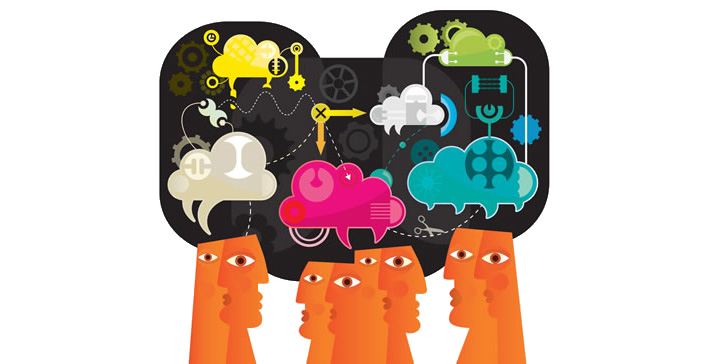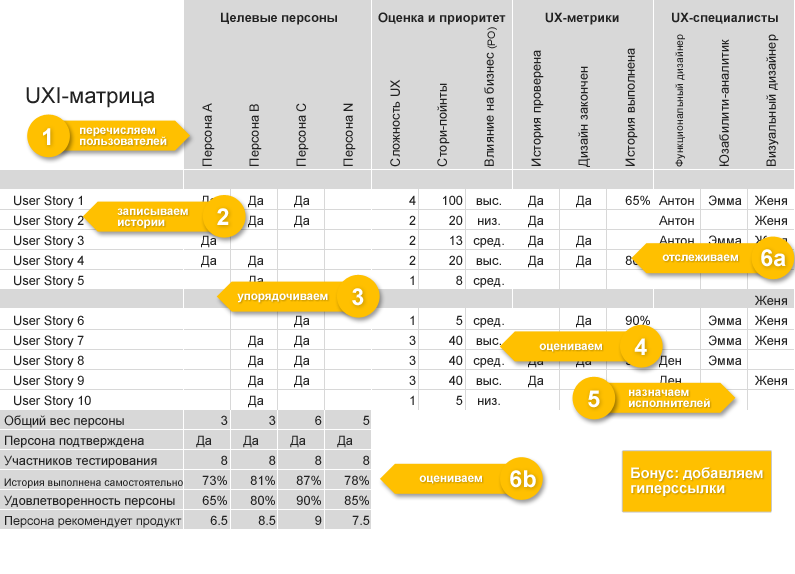Making fusion of agile development and User Experience (UX)
The author of the original idea of this article is John Innes, a consultant in the field of agile IT development methodologies. The source can be found here . We finalized it a bit, simplified it a lot, but now the article, at least, can be read :)

So, there is such a thing as user experience (the same UX, User Experience). In general, UX is the user's impression of your product (for example, a site). This includes the appearance, ease of location of buttons, links and other elements.
Why is it important to take into account the experience of interaction? Elementary: the user is comfortable on the site - you make a profit. The user got lost, upset, and closed the tab in the browser - accordingly, you get nothing. Just like twice two.
And the sad thing is - if you fix it with UX - when developing, then you will lose money (marketing budget) constantly. It’s better to immediately do it “cute, sexy, mimimi ;-)”.
At first, agile development did not take UX into account at all. And no wonder - after all, Agile pioneers worked on their own IT projects (special software) or wrote corporate software. Take into account user habits? What other, excuse me, users?
Currently, most of the software being developed is based on the interests of the end user. Nevertheless, we have two main problems that need to be overcome: the inability to measure the degree of convenience of the software product (the same experience of interaction, UX) and the inability to receive constant feedbackfrom users.
The purpose of the UX matrix is to solve these problems by linking Project Backlog and UX. First, fill out such a plate - the data will be needed to build the matrix in the future:
For example, we are designing an e-bookstore where they can be downloaded after making a payment.
We come up with the first person, let it be, for example, “Student Vasya” (a small description of the person helps a lot, for example, “studying for a marketer, first year, loves new gadgets, has his own accounts on social networks”).
We make up stories for the person.
As in traditional Scrum methods, UX specialists (analysts and web designers) break stories into specific tasks. The results will subsequently be fixed on the kanban board, as well as development tasks and implemented in the Backlog using the integration UX-matrix.
Important: the specific weight is assigned to persons. The representative of the main target audience will have a greater influence (priority), non-target - accordingly, less. Stories are evaluated by the Product Owner in terms of each affecting the goals of the business. With all this in mind, the tasks in the Backlog will be streamlined.
When the stories of this person are finished, we evaluate them according to the table and proceed to the next person, who pursues her own, different from Vasins, goals-stories. For the accuracy of the information, each person is confirmed using research on living people (receives statistical confirmation).
The result of our work should be such a matrix:

“The story is made independently” - what percentage of the tested users could complete the story without outside help.
The meaning of this seemingly complex approach, in particular, is that the task for performers acquires a completely new meaning. Compare:
Before: “Draw social recommendation buttons under the product image”
Now:"Add a tool to help the user share their favorite product with friends."
At first glance, the same thing. However, in the first case, the task is a simple recitation, “do it”, without bringing any arguments.
In the second, the task does not contain an authoritarian indication, but a goal, forcing UX specialists to seek a solution based on the real needs of customers. A usability analyst, if one is in the team, will be engaged in preliminary research aimed at improving the convenience of the software for users, the functional designer will design the interface part, and the visual designer will produce the final product.
Next - the project will go into development, programmers will evaluate the implementation according to all Agile rules (by the way, it is recommended as an evaluation toolPlanning Poker ) and, in the end, will see the light in the face of users.
It is important that the project is already based on user experience in the beginning, and, therefore, it is more viable, because its design now reflects not a particular person's idea of convenience, but is based on the experience of interaction between the users themselves.
So what do we get in the output? A design that is convenient to use, and not just a beautiful wrapper. Each user's need is analyzed before being embodied in a layout - therefore, now our site meets the definition of “business tool”. So you don’t have to worry about “leakage of the marketing budget” through holes due to an ill-conceived design. And this is good.
Threat.Those who love Agile as much as we do get a bonus as a present - the same matrix in the excel file: docs.google.com/spreadsheets/d/16ZbCnVMeGer09EGkIIVZmqsKfU_8R-DEJg0WJ9GSfzE/edit?usp=sharing
Allows you to sort, organize. to enter their meanings - in general, to own, use and dispose for the benefit of flexible processes.

So, there is such a thing as user experience (the same UX, User Experience). In general, UX is the user's impression of your product (for example, a site). This includes the appearance, ease of location of buttons, links and other elements.
Why is it important to take into account the experience of interaction? Elementary: the user is comfortable on the site - you make a profit. The user got lost, upset, and closed the tab in the browser - accordingly, you get nothing. Just like twice two.
And the sad thing is - if you fix it with UX - when developing, then you will lose money (marketing budget) constantly. It’s better to immediately do it “cute, sexy, mimimi ;-)”.
At first, agile development did not take UX into account at all. And no wonder - after all, Agile pioneers worked on their own IT projects (special software) or wrote corporate software. Take into account user habits? What other, excuse me, users?
Currently, most of the software being developed is based on the interests of the end user. Nevertheless, we have two main problems that need to be overcome: the inability to measure the degree of convenience of the software product (the same experience of interaction, UX) and the inability to receive constant feedbackfrom users.
The purpose of the UX matrix is to solve these problems by linking Project Backlog and UX. First, fill out such a plate - the data will be needed to build the matrix in the future:
| Column name | Possible values I | Description |
|---|---|---|
| A person | Name of person | Defines the person to which this or that user story is applicable. |
| Difficulty UX | from 1 to 5 | Estimates the designer’s implementation costs. |
| History Verified | Well no | Is this story a fact or a fiction? Is it based on research and statistics? |
| Design is finished | Well no | Does the design meet the requirements of the developers (technical feasibility) |
| Task completion rate | from 0 to 100% | Percentage of users who completed the story without assistance. |
| Staffing | Resource | Who is responsible for the design |
For example, we are designing an e-bookstore where they can be downloaded after making a payment.
We come up with the first person, let it be, for example, “Student Vasya” (a small description of the person helps a lot, for example, “studying for a marketer, first year, loves new gadgets, has his own accounts on social networks”).
We make up stories for the person.
- Student Vasya wants to buy a book, he knows only the name of the author and the fact that the book has few pages.
- Student Vasya wants to be in the know when book N of author X appears on sale.
- Student Vasya would like to buy several books at once and pay with his e-wallet.
- Student Vasya wants to see which of his friends read a book.
- Student Vasya wants to add comments to the read book, but does not want to log in to the site.
As in traditional Scrum methods, UX specialists (analysts and web designers) break stories into specific tasks. The results will subsequently be fixed on the kanban board, as well as development tasks and implemented in the Backlog using the integration UX-matrix.
Important: the specific weight is assigned to persons. The representative of the main target audience will have a greater influence (priority), non-target - accordingly, less. Stories are evaluated by the Product Owner in terms of each affecting the goals of the business. With all this in mind, the tasks in the Backlog will be streamlined.
When the stories of this person are finished, we evaluate them according to the table and proceed to the next person, who pursues her own, different from Vasins, goals-stories. For the accuracy of the information, each person is confirmed using research on living people (receives statistical confirmation).
The result of our work should be such a matrix:

“The story is made independently” - what percentage of the tested users could complete the story without outside help.
The meaning of this seemingly complex approach, in particular, is that the task for performers acquires a completely new meaning. Compare:
Before: “Draw social recommendation buttons under the product image”
Now:"Add a tool to help the user share their favorite product with friends."
At first glance, the same thing. However, in the first case, the task is a simple recitation, “do it”, without bringing any arguments.
In the second, the task does not contain an authoritarian indication, but a goal, forcing UX specialists to seek a solution based on the real needs of customers. A usability analyst, if one is in the team, will be engaged in preliminary research aimed at improving the convenience of the software for users, the functional designer will design the interface part, and the visual designer will produce the final product.
Next - the project will go into development, programmers will evaluate the implementation according to all Agile rules (by the way, it is recommended as an evaluation toolPlanning Poker ) and, in the end, will see the light in the face of users.
It is important that the project is already based on user experience in the beginning, and, therefore, it is more viable, because its design now reflects not a particular person's idea of convenience, but is based on the experience of interaction between the users themselves.
So what do we get in the output? A design that is convenient to use, and not just a beautiful wrapper. Each user's need is analyzed before being embodied in a layout - therefore, now our site meets the definition of “business tool”. So you don’t have to worry about “leakage of the marketing budget” through holes due to an ill-conceived design. And this is good.
Threat.Those who love Agile as much as we do get a bonus as a present - the same matrix in the excel file: docs.google.com/spreadsheets/d/16ZbCnVMeGer09EGkIIVZmqsKfU_8R-DEJg0WJ9GSfzE/edit?usp=sharing
Allows you to sort, organize. to enter their meanings - in general, to own, use and dispose for the benefit of flexible processes.
